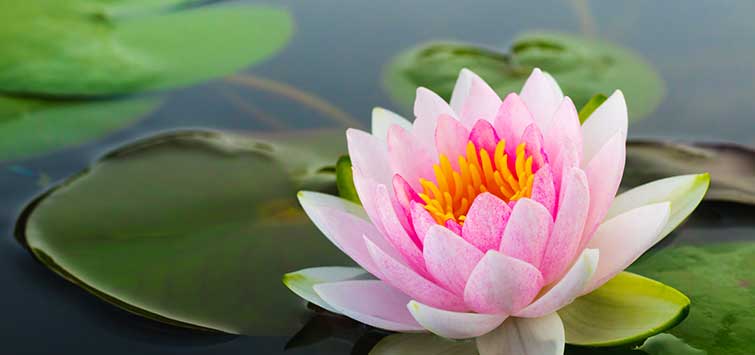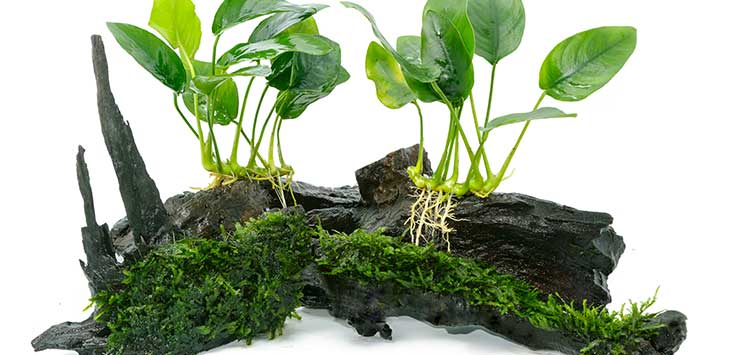Bring Your Pond to Life with Tropical Lilies
Author: Mark Denaro
Tropical water lilies can play a large part in emphasizing the beauty and tranquility of a garden pond through their dramatic coloration and elegant contours.
Pondkeepers install water gardens for a variety of reasons. For instance, a well-designed and constructed water garden can enhance any setting and add value to a property. Other reasons may include a desire to keep koi or goldfish, the wish to create a peaceful setting for relaxation and reflection, or even the attraction of water lilies and other pond plans. The reasons for keeping a water garden are as many and as varied as the number of water gardeners and the types of ponds they keep.
I have always been more attracted to the water lilies and other plants, so the fish take a secondary role in my ponds. I have kept many different water lilies over the years, and, as with anything else, I have my favorites. It is very difficult to rank flowers, but I’ve given this a lot of thought lately and have narrowed the list to my personal top-10 tropical water lilies.
I have considered the color and growth form of the flower as well as the color of the pads, but have not taken the overall size of the plant into consideration, as that would require creating a top 10 for small ponds or tub gardens and a separate top 10 for larger installations. I do find that I have a bit of a preference for blue and purple tropicals, at least in part because these colors cannot be found in hardy lilies.
Tropical Versus Hardy Lilies
Many pondkeepers, particularly beginning pondkeepers, choose to add only hardy lilies to their water gardens. The idea that hardy lilies can overwinter in the pond appeals to our thrifty side and seems like the way to go. I believe that this is one of the most common mistakes that water gardeners make.
There are some real differences between hardy and tropical lilies that make the addition of both more interesting and more visually appealing. The edges of hardy lily pads are smooth, while the edges of tropical lilies are serrated. Hardy lilies tend to hold their flowers at the surface of the water, whereas tropical lilies hold their flowers well above the surface. If well fertilized, tropical lilies produce more flowers than their hardy brethren.
Most hardy lilies open their flowers in the late morning and close them in the late afternoon. There are two types of tropical lily flowers, both of which have unique blooming characteristics. Most of the day bloomers open in mid morning and close in the late evening, while most night bloomers open in the evening and close in the mid to late morning.
The time of day that the water gardener can spend observing and enjoying the pond should be considered when choosing lilies, so there will be flowers open at that time. If your intention is to sit by the pond in the evening and relax with a glass of wine, day-blooming tropical lilies are definitely the ones you’ll want. Alternatively, if you plan to eat breakfast by the pond, you’ll want to add a tropical night bloomer or two.
Keeping Tropical Lilies
It is important to remember that these are tropical plants, and much like tropical fish, they need warm water to do well. They should not be planted until the water temperature in the pond is consistently at or above 70°F.
· Tropical lilies should be planted in large pots 16 to 24 inches in diameter. Ideally, they should be planted in a heavy clay soil topped with a thin layer of gravel to help prevent the soil getting stirred up by digging fish. The crown or growing tip of the bulb should be just above the surface of the substrate. The pot should be positioned in the pond so that the top of the pot is 12 to 18 inches below the water’s surface. Planting them too deeply may have a negative effect on flower production. Energy expended to grow to reach the surface cannot be diverted into producing flowers.
· If possible, place them in an area that receives full sunlight and has little surface agitation from a waterfall or fountain. Purchase a good tablet fertilizer and add it to the pot regularly as the manufacturer suggests in order to maximize flower production.
· If you have a large indoor aquarium or watering trough, it is possible to keep your tropical lily alive throughout the winter so it can be replanted in the pond the following season, but doing so requires very intense light. It is easier to replace the plant in most cases. The cost of electricity to run the required lighting may easily exceed the cost of purchasing a new plant. If you need to purchase a tank or vat to house the plant, you are almost certainly going to spend less to purchase a new lily next year. Of course, if you live in the south or southwest and your water temperature will remain at or above 70° year-round, this is moot, and you can just leave the lily in the pond.
Top 10
10. St. Louis Gold
The entirely yellow flowers of St. Louis gold lilies open in late morning and usually stay open until after sunset. The 5- to 6-inch-diameter flowers really stand out against the olive green pads. New pads are somewhat bronzy in color but change to a deep olive green as they grow. St. Louis gold lilies typically grow 4 to 6 feet in diameter.
9. Shirley Bryne
The dark-pink flowers of Shirley Bryne, a day-blooming cultivar, are 5 to 6 inches in diameter and feature a yellow center. They are set off nicely by the bright green pads. Shirley Bryne can tolerate somewhat less than full sun but will still be at its best if it receives a full day of sunlight. It grows to approximately 5 feet in diameter. This is a viviparous variety, meaning new plants will form attached to the older pads. These can be cut and replanted.
8. Queen of Siam
The second pink day bloomer in the countdown, queen of Siam, features large, deep-pink flowers that contrast nicely with its burgundy-and-green-mottled pads. The mottled pads give queen of Siam the leg up over Shirley Bryne. This is a large lily that can grow to a diameter of 8 to 10 feet, so it is not suitable for smaller water gardens.
7. Janice C. Wood
The flowers of Janice C. Wood, a day bloomer, are brilliant white with yellow centers. The pads are green with some purplish mottling. Janice C. Wood typically grows to a diameter of 5 to 6 feet, and the flowers are 5 to 6 inches across.
6. Trudy Slocum
The most beautiful of the white night bloomers, in my opinion, is Trudy Slocum. The fragrant flowers open around sunset and stay open until noon so they can be enjoyed throughout the morning. The flowers are about 6 to 8 inches across and have yellow centers, and the overall diameter of the plant is 6 to 9 feet. The pads are green.
5. Leopardess
The leopardess is a somewhat uncommon variety, but it is well worth the effort to seek it out. The bright-blue flowers of this day bloomer really jump out when viewed against the heavily mottled pads. The flowers are spectacular, but the pads may actually outshine them, as their pattern is truly striking. Leopardess flowers are usually about 5 inches across, and this is one of the smaller lilies in the countdown, typically growing to a diameter of 4 to 6 feet, though they can grow larger if they have the space.
4. Director George T. Moore
A true classic that has stood the test of time is director George T. Moore. The fragrant, violet to purple flowers can be up to 10 inches in diameter and bloom during the day. The pads are deep green with some purple mottling. It grows fairly large, usually about 7 to 8 feet across, but is capable of reaching 10 feet if it is not crowded.
3. Foxfire
I want to note that I have never personally kept a foxfire, but it is available in the market and is quite the show stopper. The flowers are very unusually colored: The outer petals are blue, and the inner petals are pink with a yellow center. They can grow to approximately 5 to 7 inches in diameter and bloom during the day. The pads are almost maroon with green mottling. The overall plant reaches a diameter of 7 to 10 feet. This winner of Best New Water Lily of 2004 is one that must be seen to be fully appreciated.
2. Red Flare
The red flare was my first night-blooming lily, and it still holds a special place for me. It’s definitely my favorite night bloomer, featuring vibrant, deep-red flowers and coppery maroon pads, which make a wonderful contrast when planted among the deep green of hardy lilies. The 6- to 9-inch-diameter flowers open around dusk and stay open until about noon. The plant typically grows to a diameter of 5 to 8 feet.
1. Blue Gigantea
This Australian native may be a difficult and demanding plant, but it is one that is truly worth the extra effort required. The day-blooming flowers can be a foot across and are absolutely spectacular with blue outer petals and light-blue inner petals. The stalks that support the flowers are large and have many air channels.
They were supposedly used as breathing tubes by aborigines when it was necessary to hide underwater. The first time I saw one, back in the late 1980s, it stopped me in my tracks. I probably stared at it for a full five minutes before I moved again.
Blue gigantea was brought to the United States in the 1800s, making it an oldie but a goodie. It really needs warmer water and should not be planted until the water temperatures are above 75° (above 80° is even better). It is particularly well suited to growing in greenhouses due to its need for warmer water. The pads are an attractive medium green, and the plant grows to a diameter of 7 to 10 feet.
Honorable Mentions
There are numerous honorable mentions, a few of which are particularly noteworthy. Green smoke has greenish blue flowers of a hue I’ve never seen in any other flowering plant. Albert Greenberg is a changeable lily whose flowers change among shades of yellow, orange, and pink each day.
The best tropical lily for small water gardens or even tub gardens is probably Dauben, which seldom exceeds 4 feet in diameter and can be grown in tubs as small as 2 feet in diameter. It has light-blue flowers and is viviparous, with new plants growing out of the center of older pads.
One that will hopefully start appearing on the market in some numbers this year is ultra violet. I have not kept this variety and have only seen one plant, but it was gorgeous with its deep-violet flowers. I did not include it in the countdown because it is not readily available at the time of writing. It was the winner of the Best New Water Lily award of 2008.
No matter what color or type you choose, the addition of tropical lilies will add a new dimension to your water garden. If you’ve only kept hardy lilies, take the plunge this season—try a tropical!

.png?h=595&iar=0&w=2781&hash=5FD5E69473BCC22199FBFA2FB71B6033)



